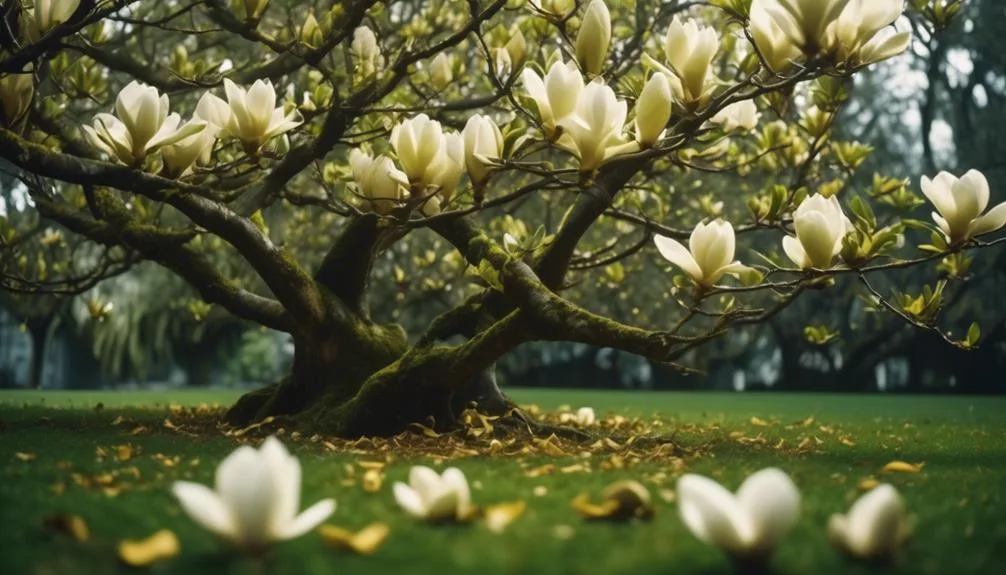Ever noticed magnolia trees losing their leaves in the middle of summer? Despite their reputation for lush foliage, this sight can puzzle many. However, there's a logical explanation for this.
Understanding why magnolia trees shed their leaves during warmer months can give insights into their biology and environmental adaptations. What causes this unexpected leaf drop? Stay tuned to uncover the fascinating factors at play and their impact on these majestic trees.
Magnolia Tree Biology
If you're curious about the inner workings of magnolia trees, their biology holds the key to understanding their growth, development, and unique characteristics.
Magnolia tree growth is a fascinating process that begins with nutrient absorption. The roots of the magnolia tree play a crucial role in this process, drawing up water and essential nutrients from the soil. These nutrients, including nitrogen, phosphorus, and potassium, are essential for the tree's overall health and development.
As the tree absorbs these nutrients, it undergoes growth and development, producing new leaves, flowers, and branches. Understanding the intricate biology of magnolia trees provides insight into their resilience and ability to thrive in various environments.
It's a testament to the remarkable adaptation and survival strategies that these remarkable trees have developed over time.
Environmental Stress Factors
As you explore the environmental stress factors affecting magnolia trees, consider how their remarkable biology equips them to withstand various challenges and adapt to changing conditions.
Climate change can significantly impact magnolia trees, causing irregular temperature fluctuations and extreme weather events. These changes can disrupt the tree's natural growth cycles, leading to stress and potential leaf loss.
Moreover, soil quality plays a crucial role in a magnolia tree's well-being. Poor soil conditions, such as compacted soil or nutrient deficiencies, can put stress on the tree, affecting its overall health and potentially resulting in leaf shedding.
Understanding these environmental stress factors is essential in maintaining the health of magnolia trees and mitigating the impacts of climate change and soil quality issues.
Seasonal Leaf Shedding
Seasonal leaf shedding in magnolia trees occurs as a natural response to the changing environmental conditions and the tree's life cycle. The leaf cycle of magnolia trees involves shedding older leaves to make way for new growth.
As weather patterns shift from warm to cold, or vice versa, the trees enter a phase of dormancy, triggering the shedding of leaves. During this process, the tree reabsorbs nutrients from the older leaves, preparing for the upcoming growth season. Factors such as temperature, daylight, and moisture levels influence the timing of leaf shedding.
In response to these changes, the tree strategically releases its leaves to conserve energy and resources. This natural mechanism ensures the magnolia tree's survival and primes it for robust growth in the following season.
Drought and Heat Response
During periods of drought and heat, magnolia trees adapt their leaf shedding process to conserve water and withstand the challenging environmental conditions.
Drought adaptation in magnolia trees involves a series of physiological responses aimed at reducing water loss. The trees close the stomata on their leaves to minimize transpiration and prevent excessive water loss. Additionally, they may shed older leaves to prioritize water and nutrients for newer growth.
Magnolia trees also exhibit remarkable heat tolerance. They've evolved to withstand high temperatures by developing thick, waxy cuticles on their leaves, which reduce water loss and protect against heat stress. Furthermore, their deep root systems enable them to access water from lower soil layers during dry periods.
These adaptive mechanisms allow magnolia trees to survive and thrive in the face of drought and heat, ensuring their long-term resilience in challenging environmental conditions.
Magnolia Tree Care
To properly care for magnolia trees, there are several important factors to consider. First and foremost, ensure that your magnolia trees receive adequate water, sunlight, and well-draining soil. Magnolias require consistent moisture, especially during dry spells and the first few years of growth, so be sure to water them deeply. Additionally, mulching around the base of the tree can help retain moisture and regulate soil temperature.
In terms of sunlight, magnolias thrive in full sun to partial shade. It is crucial to ensure that they receive at least 6 hours of direct sunlight daily to promote healthy growth.
When it comes to fertilization, it is recommended to use a balanced, slow-release fertilizer in early spring. This will provide the necessary nutrients to support healthy growth. However, it is important to avoid excessive nitrogen, as this can result in an overabundance of foliage at the expense of flowers.
Pruning techniques for magnolia trees should be minimal. Focus on removing any dead or damaged branches and shaping the tree when necessary to maintain its natural form. Pruning should be done with care to avoid excessive removal of healthy branches.
Conclusion
In understanding the natural responses of magnolia trees, we can provide better care for them, ensuring their health and vitality, even during the hot summer months.
By offering proper watering and maintenance, we help our magnolia trees thrive and adapt to environmental stress.

My interest in trees started when I first saw the giant sequoias in Yosemite.
I was a teenager then, and I remember thinking, “I need to learn more about this.”
That moment stuck with me.
A few years later, I went on to study forestry at Michigan Tech.
Since graduating, I’ve worked in a mix of hands-on tree care and community education.
I’ve spent over ten years helping people understand how to plant, maintain, and protect the trees in their neighborhoods.
I don’t see trees as just part of the landscape.
They are living things that make a real difference in our daily lives.
